How and how to feed peppers in a greenhouse?
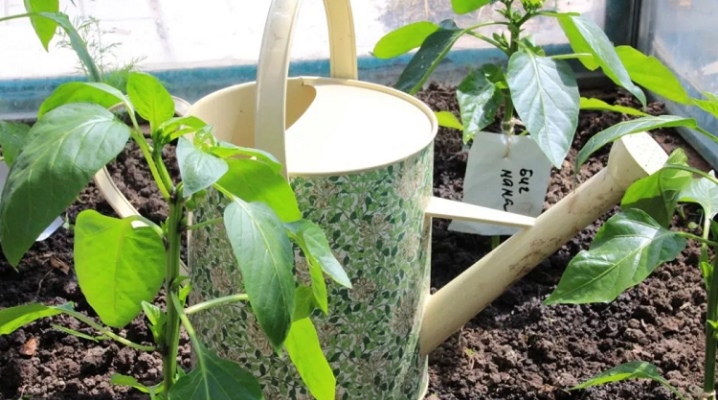
Regular fertilization is one of the most important components of greenhouse cultivation of bell peppers. Gardeners need to not only choose the right formulations, but also use them at the right stage of culture development.

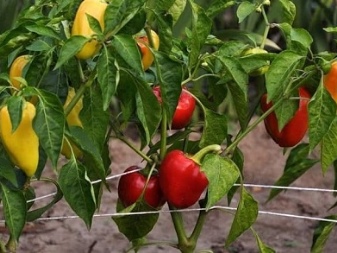
What fertilizers should you use?
You can feed peppers in an ordinary polycarbonate greenhouse with both folk remedies and ready-made mineral complexes compiled by specialists.
Mineral
All mineral fertilizers for greenhouse peppers are applied in liquid form. Powders and granules are diluted according to the instructions using heated water. The ready-made solution in most cases is only suitable for watering the soil, so it is important to ensure that the spray does not fall on the foliage or stem. If the peppers do not grow well, then they may be lacking in nitrogen. This element is most needed by the culture at the initial stage of the vegetative process. Nitrogen starvation leads to a thinning and weakening of the stem, a change in the color of the leaf plates, as well as a reduction in the number of inflorescences.
Nitrogen fertilizers in their pure form are usually applied to the soil of the greenhouse a week before planting the seedlings, and then they are combined with potassium and phosphorus preparations. Most often we are talking about urea and ammonium nitrate. Urea is often used to feed weak pepper seedlings. Approximately a couple of weeks before transplanting into the greenhouse, the seedlings are fertilized with pure urea or its mixture with potassium sulfate and superphosphate. On average, 15 days after the "move", the peppers are fed with a mixture of 30-40 grams of superphosphate, infused throughout the day, 10 grams of ammonium nitrate, the same amount of urea and 30 grams of potassium sulfate.
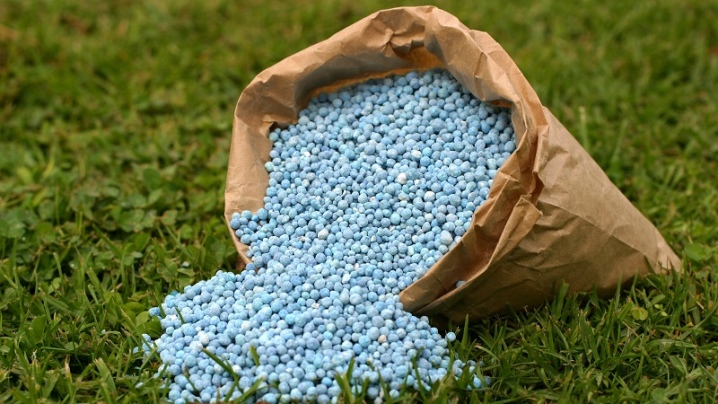
If the pepper adapts to a new place for a long time, showing thin stalks and small leaves, then foliar feeding can be carried out with the above composition. However, it is important to wait for a cloudy day and reduce your concentration.
Potash fertilization is no less important for the culture. The application of this mineral should be started during the fruit setting period and continued until the end of the harvest. Fertilizer is more convenient to use in liquid fast-acting form. To enrich the soil, it is also worth adding potassium in dry form in autumn and early spring to wet soil, combining the procedure with digging the soil. We must not forget that the vegetable reacts poorly to chlorine, therefore, potassium preparations containing it should be avoided.
Phosphorus is required for culture in the early stages of the growing season. Fertilizers containing this mineral can be water-soluble, like all superphosphates, as well as hardly soluble - for example, phosphate rock and bone meal. The former are also capable of acidifying the soil, while the latter, on the contrary, alkalinize it. The lack of phosphorus can be guessed by the appearance of a purple hue on the leaf blades. Phosphorus-containing preparations should be used several times during the summer, and also introduced in the fall during the digging of the earth in the greenhouse.
Generally, all of the above drugs are very successfully combined with each other. Top dressing of 10 grams of potassium sulfate, 35 grams of superphosphate, as well as 5 grams of carbamide, diluted in 10 liters of water, has proven to be excellent.With this mixture, peppers are irrigated at the initial stage of flowering, and it is spent somewhere in a liter for each bush. In the midst of flowering and the formation of ovaries, ammonium nitrate, ammonium sulfate, potassium monophosphate and potassium magnesium are already added.
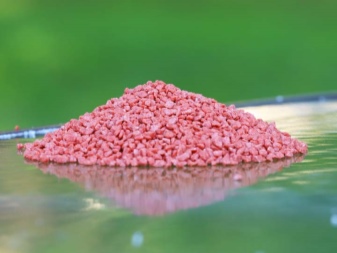
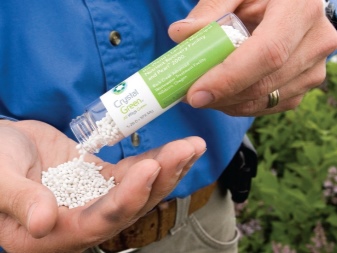
Organic
Organic fertilizers include nutrients obtained naturally. So, to improve the soil in the greenhouse, compost or rotted sawdust is often used. To prepare the latter, several layers are formed from fresh ones, each of which is watered with urea diluted in water. The impregnated sawdust is wrapped in cellophane and left for a couple of weeks. Once they turn black, the compost is ready for use.
Peppers are often fertilized with mullein. Such fertilizer, once in the soil, decomposes for several years, providing nutrition for the plant. In order not to provoke a burn of the culture, the mullein is introduced during the autumn digging, and for each square meter there are 4 kilograms of the substance. Mullein is also suitable for composting. This top dressing is also introduced in liquid form. In this case, a bucket of mullein is bred in four buckets of water and infused for 5 days. There are 10 liters of fertilizer for every square meter of the greenhouse.
Peat, which is a mixture of decayed residues of plant and animal origin, perfectly saturates the soil with nitrogen. In addition, the substance improves the air permeability of the soil and retains moisture for longer. Peat is rarely used in its pure form, but its use as a component of fertilizer makes it possible to accelerate the growth of pepper. At the stage of flowering and the formation of ovaries, the use of chicken manure will be successful. To prepare this top dressing, it is necessary to fill a third of the container with the key substance, fill it to the brim with water and leave to ferment from 5 days to 2 weeks. The finished tincture is also diluted in a ratio of 1 to 20 before watering.
During the fruiting of the culture, it will respond well to root irrigation with nettle infusion. To create it, 100 grams of dry raw materials will need to be poured with three liters of heated water, covered with a lid and left for 2 weeks. Before using the mixture, each part of the fertilizer will need to be diluted with two parts of water. Of course, such a "classic" top dressing as wood ash will also be useful, especially if the soil in the greenhouse is highly acidic.
The powder is either used to prepare a solution, or it is laid dry in the wells before planting.
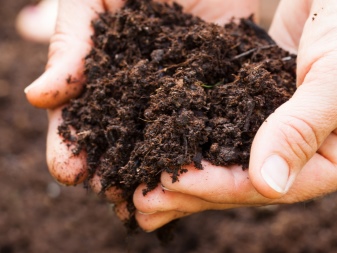
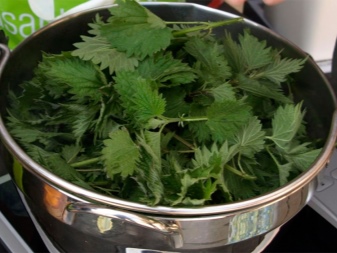
Complex
Complex fertilizers for peppers in a greenhouse include nitrogen-potassium and phosphorus-potassium mixtures. Their multipurpose action allows you to stimulate plant growth, strengthen its immunity and increase resistance to temperature fluctuations. One of the most popular complexes is Kemira Lux. Top dressing that requires dilution with water includes phosphorus, potassium and nitrogen. The "Riga mixture", which contains boron, zinc, manganese, iron and other necessary microelements, is excellent.
The necessary effect will be achieved when choosing any complex fertilizer intended for nightshades:
- "Hera";
- "Fasco";
- Agricola;
- "Clear sheet".
At the stage of fruit formation, it makes sense to use "Bud", whose components increase the number of ovaries and accelerate the development of peppers.
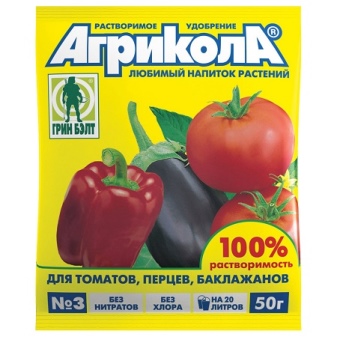
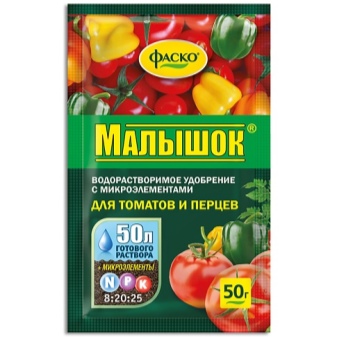
Folk remedies
It will be possible to feed the peppers in the greenhouse without the use of chemicals. Such folk dressings are always at hand, differ in the minimum cost and are absolutely safe for all "participants" in the process.
- For example, a decoction of banana skins, infused for three days, will saturate the earth with potassium. For its preparation, the peel of 4 fruits is poured with three liters of heated water and infused for about 3 days. This top dressing can be used once a week during flowering and fruit formation.
- A similarly prepared infusion of onion husks can effectively disinfect the soil.
- Infusion of raw or dry yeast will increase the content of nitrogen and phosphorus in the soil.
- The use of iodine is very useful for culture. A couple of drops of the medicine are diluted in a liter of water and mixed with 100 milliliters of whey or milk. The ready-made mixture accelerates the growth of bushes, strengthens their immunity and improves the taste of peppers. With this tool, the leaf plates are sprayed on both sides.
- Eggshells are considered an important source of potassium. It can be either infused, increasing the growth of the foliar part of the culture, or used as a powder as an additive to compost.
- Ammonia will fertilize the soil and destroy pests, and the dried tea leaves will enrich the soil.
- Boric acid can work as a stimulant. As a rule, 5 grams of powder is diluted in 5 liters of water. This should be done in a certain way: first, the substance dissolves in a small amount of hot liquid, and then combines with the required amount of cold liquid.
The culture is sprayed with a solution that will also scare off many pests at the beginning of flowering and at the stage of the appearance of the first ovaries.


Features of top dressing
Top dressing of sweet peppers in the greenhouse should be done according to a schedule based on the phases of crop development.
- The first feeding is carried out at the seedling stage - this happens two weeks after planting the seeds. Usually, this procedure coincides in time with the appearance of the second leaf. For this stage, a solution of 60 grams of potassium nitrate and 20 liters of water is most suitable.
- After two weeks, the seedlings are enriched with a complex fertilizer containing phosphorus, nitrogen and potassium. A couple of days before landing in a permanent habitat, the culture must also be fed with a mineral complex.
- In the second week after planting the peppers, the culture is watered with mullein solution, which is necessarily accompanied by soil mulching.
- During flowering and fruiting, the peppers should be properly fed with potassium and phosphorus.
- In order to successfully set the fruits, it makes sense also at the flowering stage to use urea, potassium sulfate and superphosphate so that there is a liter of the product for each bush.
- To have a good harvest, the bushes can be treated with herbal infusion, which includes dandelion, clover, nettle, coltsfoot and other plants. The green mass is infused for about a week, after which it is filtered, diluted with warm water and supplemented with wood ash.
- By the way, foliar top dressing will also be useful for pepper, providing a quick assimilation of nitrogen, which means a better development of the culture. It is better to spray the bush to form the ovary before 11 am or after 5 pm. This must be done when the soil temperature drops below 15 degrees, or the air temperature rises above 33 degrees. It is important not to forget that foliar feeding is much better perceived by blooming or diseased peppers.

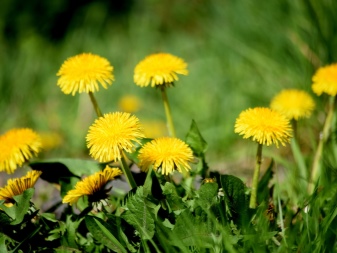
In general, for the successful cultivation of a culture, it is enough to remember a few rules:
- the use of drugs should occur after abundant irrigation and be accompanied by loosening of the topsoil;
- it is better to alternate organic matter with mineral compositions;
- it is necessary to learn how to determine the need for a culture in a particular element and modify the feeding based on this;
- it is customary to fertilize greenhouse peppers no more than once every 14 days, given that an excess of agrochemistry leads to the accumulation of nitrates in the pulp of the fruit;
- for greenhouses, organic matter is preferred: mullein, ash or bird droppings;
- root dressing should be carried out correctly in the morning hours, pre-heating the solution in a natural way up to 25 degrees;
- foliar feeding will be more successful on a cloudy day.
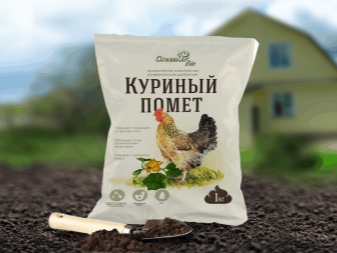
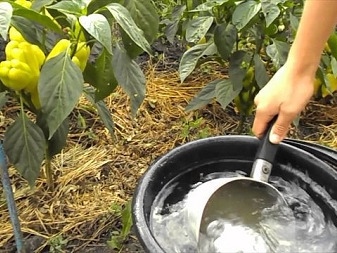
Helpful hints
At the stage of seedling germination, it should be remembered that an excessive amount of urea will make it difficult for seeds to germinate. In the future, an excess of nitrogen fertilizers will lead to an excessive concentration of ammonia, which can negatively affect the state of seedlings and their development. Too much nitrogen provokes a rapid growth of the culture, as a result of which it is depleted and loses its immunity. In addition, there is an increase in shoots to the detriment of the ovaries. In no case should fresh manure or mullein be introduced into the ground, since the undiluted substance will burn the roots of the plant. The same negative effect can occur when fertilizing dry soil.
Liquid fertilizers should be watered exactly at the root, without splashing on the stems and leaf blades of the crop. The water used to dilute the components must be warm and settled. If the summer is cool, then the peppers will need potassium to maintain immunity. It is better to try to carry out foliar feeding in the morning, since drops that have not dried up in the evening can cause the development of a fungus. Despite the fact that the norm is the introduction of fertilizers every two weeks, some gardeners prefer to do it more often - once every 3-4 days, but with the preparation of a solution of weak concentration.
Each bush usually accounts for from 0.5 to 1 liter of solution, but the amount can and should vary depending on the condition of the plant, as well as the components of the fertilizer.
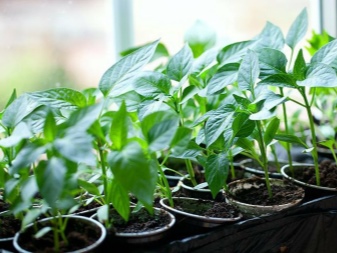
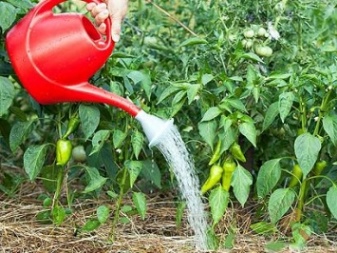
For information on when, how and what to feed the peppers in the greenhouse, see the next video.













The comment was sent successfully.